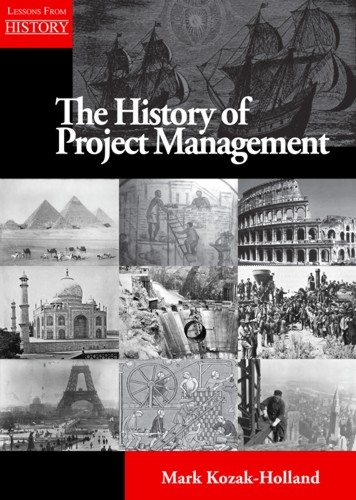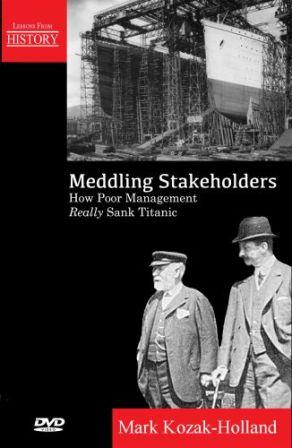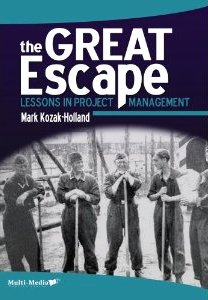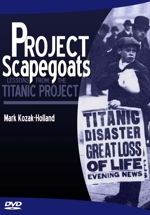LFH Overview
DVD CD page
MP3/DVD/CD from the Series
Audio - An Introduction to the History of Project Management [MP3]
 |
The audio addresses the origins of project management and the general perception that it was initiated and evolved in the 20th century. Yet how were all the great projects of the past delivered, like the Giza Pyramid, the Parthenon, the Colosseum, the Gothic Cathedrals of Europe, and the Taj Mahal. Was project management used? Were the concepts of project management understood? This audio presents the case that the discipline of project management did not just appear in the last 100 years but has been part of a steady evolution for at least 4,500 years. It takes a hard look at the history of project management, how it evolved, and presents some quite remarkable results. Project Management Association of Canada Award Winner for 2010 |
Video - Meddling Stakeholders: How Poor Management Sank Titanic [DVD]
 |
The process of gathering and managing requirements can be difficult enough but when stakeholders start to meddle a project can get quickly out of control.
|
Audio - Winston Churchill, the Agile Project Manager [CD/MP3]
 |
The Adaptive Enterprise is a modern concept, or is it? This audio explores how Churchill and his Cabinets' actions, under tremendous pressure in May 1940, transformed their organization to the modern-day version of an Adaptive Enterprise. By definition an Adaptive Enterprise modifies organizational behaviour, how it addresses and responds to change, to give it a competitive edge. This audiobook looks back at a period of incredible change and mines lessons that Project Managers can use today. |
Video - Winston Churchill, the Agile Project Manager [DVD]
 |
Today’s pace of change has reached unprecedented levels only seen in times of war. As a result, project management has changed accordingly with the pressure to deliver and make things count quickly. This DVD looks back at a period of incredible change and mines lessons for Project Managers today. In May 1940, the United Kingdom (UK) was facing a dire situation, an imminent invasion. As the evacuation of Dunkirk unfolded, the scale of the disaster became apparent. The army abandoned 90% of its equipment, the RAF fighter losses were deplorable, and over 200 ships were lost. |
Audio - Project Lessons from the Great Escape (Stalag Luft III) [CD/MP3]
 |
The Great Escape from the prison camp Stalag Luft III is widely regarded as one of the most audacious and daring escape attempts of the 20th century. But as an event in March 1944, set in dire circumstances, what actually happened? How was the escape planned and executed? How did it get around numerous obstacles in a habitat designed to be escape proof? How was the project tracked? In today's world, business people are grappling with numerous obstacles in planning and executing projects in a climate of rapid changes. What can be learned from this event and put into practice today?
This audio recording of a live presentation analyzes how the escape was planned and executed as a project. Everything in Stalag Luft III was set up to prevent escape. The project planning and preparation were hindered every day by new obstacles. The environment was ripe for a project failure. Yet the escape committee (project team) was able to organize itself and remove each obstacle it faced. The escape committee overcame continuous difficulties and ran the project in an agile fashion. |
Video - Project Lessons from the Great Escape (Stalag Luft III) [DVD]
 |
While you might think your project plan is perfect, would you bet your life on it? In the Second World War, a group of 220 captured airmen did just that -- they staked the lives of everyone in the camp on the success of a project to secretly build a series of tunnels out of a prison camp their captors thought was escape proof. The prisoners formally structured their work as a project, using the project organization techniques of the day. This DVD recording of a live presentation analyzes how the escape was planned and executed as a project.
The project planning and preparation were hindered every day by new obstacles. The environment was ripe for a project failure. Yet the escape committee (project team) was able to organize itself and remove each obstacle it faced. The escape committee overcame continuous difficulties and ran the project in an agile fashion.This meant understanding the problems facing them, focusing slender resources on the immediate task in hand, unifying the camp prisoners, and directing these into the project. With very little time the escape committee transformed the camp into an agile project one that could adapt to changing and unexpected daily situations. |
Audio - Project scapegoats [CD/MP3]
 |
Building upon the popularity of the first book in the Lessons from History series, this audio presents lessons for project managers harvested from the project that designed, built, and launched the R.M.S. Titanic. Full of practical advice, this audio builds on the most notorious "failed project" in recent memory, the sinking of an "unsinkable" ship. The sinking of Titanic is one of the worst maritime disasters ever. |
Video - Project scapegoats [DVD]
 |
Imagine you are in one of Titanic's lifeboats, drifting away from the sinking ship. As you look back, you wonder how such a disaster could have happened. Titanic's maiden voyage was a disaster waiting to happen as a result of the compromises made during its construction project. This DVD explores how Executives & Project Managers can take lessons from this nuts-and-bolts construction project and apply them to their projects today. |

